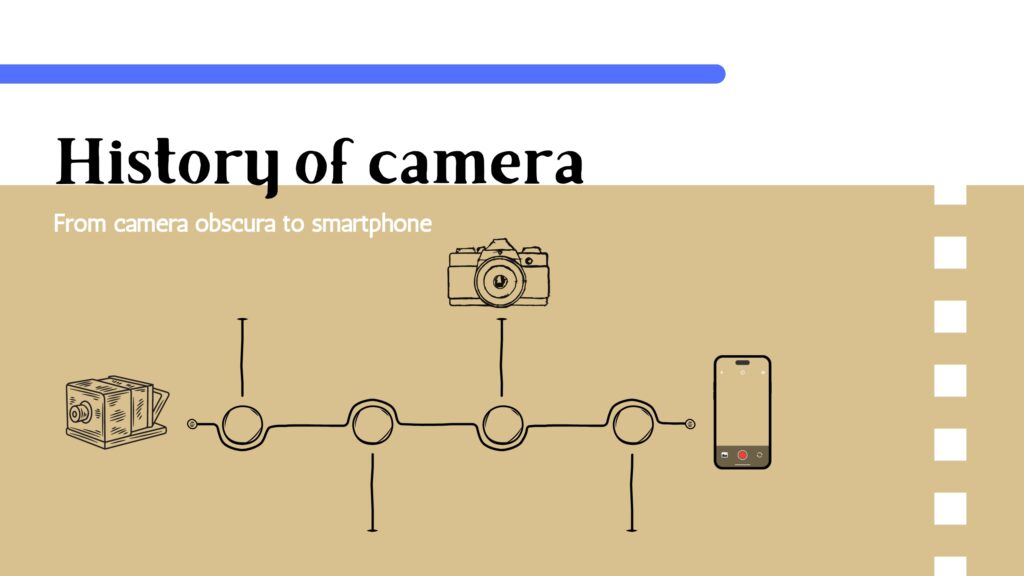The camera is an invention that has dramatically changed the way we see and document the world around us. From the earliest pinhole cameras to the advanced digital cameras of today, the journey of camera technology is a fascinating tale of innovation and progress. This blog post will take you through the significant milestones in the timeline of camera development.

History of Camera
-
5th Century BCThe Pinhole Camera ConceptThe foundation for photography lies in this simple device.
The concept of the pinhole camera, also known as the camera obscura, dates back to ancient times. Chinese philosopher Mozi and Greek philosopher Aristotle both mentioned the principles of a pinhole camera.
The device projected an image of the outside world onto a surface inside a dark room through a small hole. -
16th CenturyAdvancements in Camera ObscuraThe camera obscura evolved over the centuries, with notable advancements in the 16th century by scientists like Giovanni Battista della Porta. These improvements included the use of lenses to focus light more effectively, creating clearer and brighter images.
-
1826The First PhotographJoseph Nicéphore Niépce created the first permanent photograph in 1826 using a process called heliography. The photograph, known as “View from the Window at Le Gras,” required an exposure time of several hours.
-
1839The DaguerreotypeLouis Daguerre, a French artist and chemist, introduced the daguerreotype in 1839. This process reduced exposure times to minutes and produced clearer images on silver-plated copper sheets. The daguerreotype marked the beginning of commercial photography.
-
1840The CalotypeHenry Fox Talbot invents the calotype, a paper-based negative process. Unlike the daguerreotype, calotype negatives allowed for multiple prints, making photography more accessible.
-
1851The Collodion ProcessFrederick Scott Archer developed the collodion process, which significantly reduced exposure times and improved image quality. This wet-plate technique involved coating a glass plate with collodion and then immersing it in silver nitrate to create a light-sensitive surface.
-
1888The Kodak CameraGeorge Eastman revolutionized photography with the introduction of the Kodak camera in 1888. The Kodak was the first camera designed for roll film, making photography accessible to the general public. The slogan “You press the button, we do the rest” highlighted its simplicity.
-
1900The Brownie CameraEastman’s Kodak company launched the Brownie camera in 1900. Priced at just one dollar, the Brownie made photography affordable for millions and popularized snapshot photography.
-
191335mm FilmThe introduction of 35mm film by Oskar Barnack paves the way for smaller, lighter, and more portable cameras. This format becomes the standard for professional and amateur photography alike.
-
1930sThe Single-Lens Reflex (SLR) CameraSLR cameras offer a “through-the-lens” viewing experience, allowing photographers to see the exact image captured. This innovation significantly impacts professional photography.
-
1935The Introduction of KodachromeKodachrome, introduced by Eastman Kodak in 1935, was the first commercially successful color film. Its vibrant colors and fine grain made it a favorite among photographers and filmmakers.
-
1948The Polaroid CameraEdwin Land introduces the instant camera, revolutionizing how people experience photographs. The Polaroid camera produces instant prints, allowing for immediate gratification.
-
1975The First Digital CameraSteven Sasson, an engineer at Eastman Kodak, invented the first digital camera in 1975. This prototype used a Fairchild CCD image sensor and took 23 seconds to capture a black-and-white image with a resolution of 0.01 megapixels.
-
1991The First Professional Digital CameraKodak released the DCS-100 in 1991, the first commercially available digital SLR camera. It was based on a Nikon F3 body and had a 1.3-megapixel sensor, paving the way for professional digital photography.
-
1999The Rise of Consumer Digital CamerasThe late 1990s saw a surge in consumer digital cameras, with models like the Nikon D1 and Canon EOS D30 making digital photography accessible to enthusiasts and hobbyists. These cameras offered improved image quality and more affordable prices.
-
2000The First Camera PhoneSharp introduced the first camera phone, the J-SH04, in Japan in 2000. This innovation allowed users to capture and share images instantly, revolutionizing the way people took and shared photos.
-
2010sThe Dominance of Smartphone PhotographyBy the 2010s, smartphone cameras had evolved significantly, with models like the iPhone and Samsung Galaxy offering high-resolution sensors, advanced optics, and powerful image processing capabilities. Smartphone photography became the most popular form of photography worldwide.
-
PresentThe Rise of Computational PhotographyModern smartphones and cameras are increasingly relying on computational photography, which uses advanced algorithms and artificial intelligence to enhance image quality. Features like HDR, portrait mode, and night mode are transforming what is possible with small sensors.
-
FutureInnovations in Camera TechnologyThe future of camera technology looks promising with developments in areas such as 3D imaging, virtual reality, and augmented reality. Cameras are becoming integral to new technologies, creating exciting possibilities for the future.





